This homemade white bread is soft, fluffy, and buttery. It makes two big loaves and is perfect for sandwiches, toast, or just with some butter. You don’t need any special tools—just simple ingredients and a little time to rise.
Jump to RecipeIngredients Needed:
- 4½ teaspoons instant yeast
- ¾ cup + 2⅔ cups warm water
- ¼ cup (52 g) granulated sugar
- 1 tablespoon salt
- 3 tablespoons (43 g) unsalted butter, cubed, at room temperature
- 9 to 10 cups (1200 g) all-purpose flour
- 3 tablespoons (43 g) unsalted butter
How To Make White Bread Recipe?
- Dissolve the yeast: In a mixing bowl, stir the yeast into ¾ cup warm water and let it sit for 5 minutes until foamy.
- Mix the dough: Add the rest of the water, sugar, salt, room-temperature butter, and 5 cups of flour. Stir everything together.
- Knead the dough: Using a dough hook, mix on low and slowly add more flour until the dough feels soft and a bit sticky but not too wet. Keep kneading for 7 to 10 minutes until smooth.
- Let it rise: Place the dough in a greased bowl, flip it once to coat it all over, cover it with plastic wrap, and let it rise for 45 minutes to 1 hour until it doubles in size.
- Shape the dough: Place the dough on a floured surface and gently press to release the air. Cut it in half. Take one piece, shape it into a 9×12-inch rectangle, and roll it up tightly from the short end. Pinch the seams, tuck in the ends, and place it into a greased 9-inch loaf pan. Repeat with the second piece.
- Let it rise again: Cover the pans loosely and let the dough rise for another 30 to 45 minutes, until doubled again.
- Bake the bread: Preheat your oven to 200°C and place the rack on the lowest level. Brush the tops of the loaves with melted butter. Bake for 30 to 35 minutes, turning halfway through, until golden brown. The inside should be 90°C if using a thermometer.
- Cool the bread: Take the loaves out of the oven and brush with more melted butter. Let them cool for 10 minutes in the pans, then remove them and let them cool completely before slicing.

Recipe Tips:
- Check the water temperature before adding yeast: The water should feel warm like bath water (around 100°F to 110°F). If it’s too hot, it can kill the yeast and your bread won’t rise.
- Add flour slowly after the first 5 cups: Don’t dump in all the flour at once. Add a little at a time until the dough feels soft and slightly sticky but not wet. This helps avoid dry, heavy bread.
- Knead until the dough feels smooth and stretchy: A good dough should stretch a bit without tearing. If it tears easily, knead it for a few more minutes to develop the gluten.
- Shape the loaves tightly: When rolling the dough into loaves, make sure it’s rolled tightly with no gaps. This helps the bread rise evenly and keeps big air pockets from forming inside.
- Use a thermometer for perfect baking: To make sure it’s fully baked, check the center of the loaf. It should be 90°C. This stops you from cutting into undercooked bread.
How To Store & Reheat Leftovers?
- Refrigerate: First, let the white bread cool completely at room temperature. Then wrap it tightly in plastic wrap or place it in an airtight bag. Store it in the fridge for up to 4 days to keep it fresh.
- Freeze: After the bread has cooled to room temperature, wrap each loaf in plastic wrap and then in foil. Freeze for up to 1 month.
- Reheat: For quick reheating, just toast slices until warm and lightly crisped. It works well for sandwiches or buttered toast.
Nutrition Facts:
- Calories: 170 kcal
- Total Fat: 2.5g
- Saturated Fat: 1.5g
- Cholesterol: 7mg
- Sodium: 180mg
- Potassium: 55mg
- Total Carbohydrate: 33g
- Dietary Fiber: 1g
- Sugars: 2g
- Protein: 4g
Try More James Martin Recipes:
James Martin White Bread Recipe
Course: Side DishCuisine: BritishDifficulty: Easy20
servings20
minutes30
minutes170
kcalThis homemade white bread is soft, fluffy, and buttery. It makes two big loaves and is perfect for sandwiches, toast, or just with some butter. You don’t need any special tools—just simple ingredients and a little time to rise.
Ingredients
4½ teaspoons instant yeast
¾ cup + 2⅔ cups warm water
¼ cup (52 g) granulated sugar
1 tablespoon salt
3 tablespoons (43 g) unsalted butter, cubed, at room temperature
9 to 10 cups (1200 g) all-purpose flour
3 tablespoons (43 g) unsalted butter
Directions
- Dissolve the yeast: In a mixing bowl, stir the yeast into ¾ cup warm water and let it sit for 5 minutes until foamy.
- Mix the dough: Add the rest of the water, sugar, salt, room-temperature butter, and 5 cups of flour. Stir everything together.
- Knead the dough: Using a dough hook, mix on low and slowly add more flour until the dough feels soft and a bit sticky but not too wet. Keep kneading for 7 to 10 minutes until smooth.
- Let it rise: Place the dough in a greased bowl, flip it once to coat it all over, cover it with plastic wrap, and let it rise for 45 minutes to 1 hour until it doubles in size.
- Shape the dough: Place the dough on a floured surface and gently press to release the air. Cut it in half. Take one piece, shape it into a 9×12-inch rectangle, and roll it up tightly from the short end. Pinch the seams, tuck in the ends, and place it into a greased 9-inch loaf pan. Repeat with the second piece.
- Let it rise again: Cover the pans loosely and let the dough rise for another 30 to 45 minutes, until doubled again.
- Bake the bread: Preheat your oven to 200°C and place the rack on the lowest level. Brush the tops of the loaves with melted butter. Bake for 30 to 35 minutes, turning halfway through, until golden brown. The inside should be 90°C if using a thermometer.
- Cool the bread: Take the loaves out of the oven and brush with more melted butter. Let them cool for 10 minutes in the pans, then remove them and let them cool completely before slicing.
Notes
- Check the water temperature before adding yeast: The water should feel warm like bath water (around 100°F to 110°F). If it’s too hot, it can kill the yeast and your bread won’t rise.
- Add flour slowly after the first 5 cups: Don’t dump in all the flour at once. Add a little at a time until the dough feels soft and slightly sticky but not wet. This helps avoid dry, heavy bread.
- Knead until the dough feels smooth and stretchy: A good dough should stretch a bit without tearing. If it tears easily, knead it for a few more minutes to develop the gluten.
- Shape the loaves tightly: When rolling the dough into loaves, make sure it’s rolled tightly with no gaps. This helps the bread rise evenly and keeps big air pockets from forming inside.
- Use a thermometer for perfect baking: To make sure it’s fully baked, check the center of the loaf. It should be 90°C. This stops you from cutting into undercooked bread.

